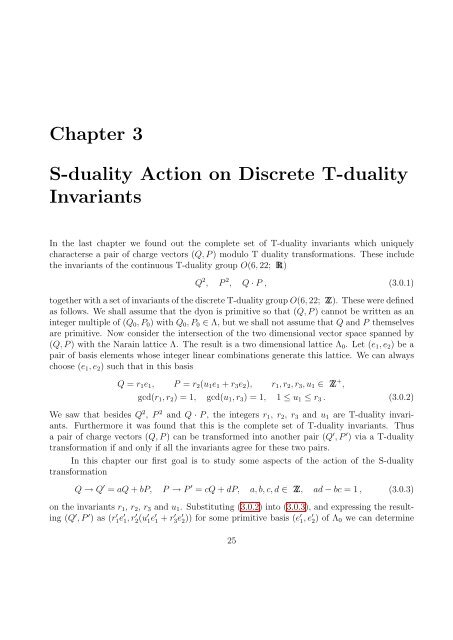PHYS08200604018 Shamik Banerjee - Homi Bhabha National ...
PHYS08200604018 Shamik Banerjee - Homi Bhabha National ...
PHYS08200604018 Shamik Banerjee - Homi Bhabha National ...
Create successful ePaper yourself
Turn your PDF publications into a flip-book with our unique Google optimized e-Paper software.
Chapter 3<br />
S-duality Action on Discrete T-duality<br />
Invariants<br />
In the last chapter we found out the complete set of T-duality invariants which uniquely<br />
characterse a pair of charge vectors (Q, P ) modulo T duality transformations. These include<br />
the invariants of the continuous T-duality group O(6, 22; R)<br />
Q 2 , P 2 , Q · P , (3.0.1)<br />
together with a set of invariants of the discrete T-duality group O(6, 22; Z). These were defined<br />
as follows. We shall assume that the dyon is primitive so that (Q, P ) cannot be written as an<br />
integer multiple of (Q 0 , P 0 ) with Q 0 , P 0 ∈ Λ, but we shall not assume that Q and P themselves<br />
are primitive. Now consider the intersection of the two dimensional vector space spanned by<br />
(Q, P ) with the Narain lattice Λ. The result is a two dimensional lattice Λ 0 . Let (e 1 , e 2 ) be a<br />
pair of basis elements whose integer linear combinations generate this lattice. We can always<br />
choose (e 1 , e 2 ) such that in this basis<br />
Q = r 1 e 1 , P = r 2 (u 1 e 1 + r 3 e 2 ), r 1 , r 2 , r 3 , u 1 ∈ Z + ,<br />
gcd(r 1 , r 2 ) = 1, gcd(u 1 , r 3 ) = 1, 1 ≤ u 1 ≤ r 3 . (3.0.2)<br />
We saw that besides Q 2 , P 2 and Q · P , the integers r 1 , r 2 , r 3 and u 1 are T-duality invariants.<br />
Furthermore it was found that this is the complete set of T-duality invariants. Thus<br />
a pair of charge vectors (Q, P ) can be transformed into another pair (Q ′ , P ′ ) via a T-duality<br />
transformation if and only if all the invariants agree for these two pairs.<br />
In this chapter our first goal is to study some aspects of the action of the S-duality<br />
transformation<br />
Q → Q ′ = aQ + bP, P → P ′ = cQ + dP, a, b, c, d ∈ Z, ad − bc = 1 , (3.0.3)<br />
on the invariants r 1 , r 2 , r 3 and u 1 . Substituting (3.0.2) into (3.0.3), and expressing the resulting<br />
(Q ′ , P ′ ) as (r ′ 1e ′ 1, r ′ 2(u ′ 1e ′ 1 + r ′ 3e ′ 2)) for some primitive basis (e ′ 1, e ′ 2) of Λ 0 we can determine<br />
25

















